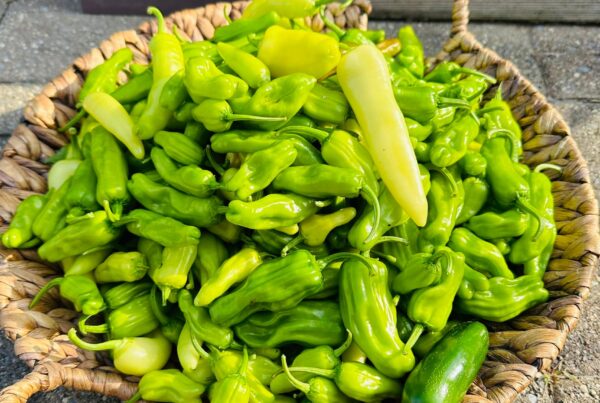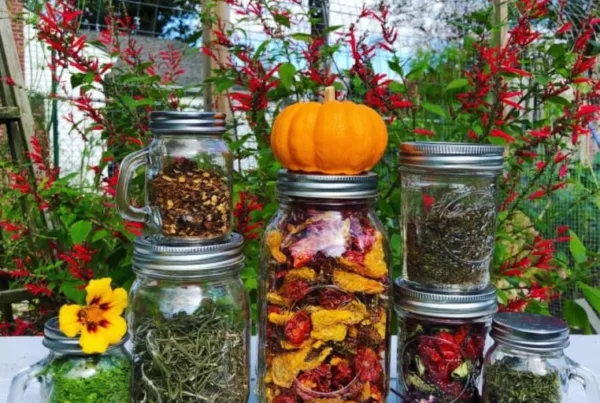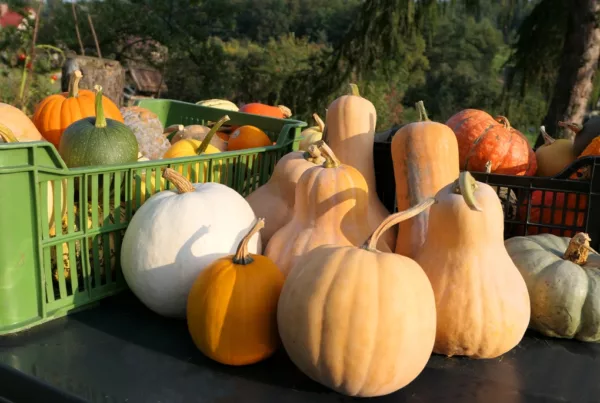 Christopher has been gardening since 2013, but his interest in the Square Foot Gardening Method began much earlier – back when he was a teenager watching Mel’s show on PBS with his brother. At that time, their parents maintained a traditional garden every year, so the family never experimented with the SFG Method. Years later, a friend had posted pictures of a beautiful SFG garden on Facebook and it immediately brought back old memories. Christopher borrowed Mel’s book from the library and later bought his own copy. Shortly after, he built his first 4’x4’ SFG bed.
Christopher has been gardening since 2013, but his interest in the Square Foot Gardening Method began much earlier – back when he was a teenager watching Mel’s show on PBS with his brother. At that time, their parents maintained a traditional garden every year, so the family never experimented with the SFG Method. Years later, a friend had posted pictures of a beautiful SFG garden on Facebook and it immediately brought back old memories. Christopher borrowed Mel’s book from the library and later bought his own copy. Shortly after, he built his first 4’x4’ SFG bed.
Today Christopher is a top contributor in our Facebook group, where he shares photos of his SFG and inspires hundreds of others to try the SFG Method. We asked him a few questions about his SFG journey and tips. We hope you enjoy reading this interview as much as we enjoyed putting it together.
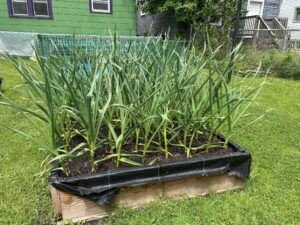
Garlic in SFG bed.
Q: Christopher, your Facebook photos show an amazing garlic harvest! Could you walk us through your process from planting to harvesting?
I usually plant one 4×4 bed with 4 cloves per square, totaling 64 cloves. My favorite variety to grow is probably the one I’ve been planting for the last several years, it’s German White. I used to buy bulbs from other local growers, but eventually, I reached critical mass and started replanting from my own harvest.

Garlic cloves ready to plant.
I take the largest bulbs and plant the biggest cloves from those bulbs. I plant in the middle of October and harvest the following year around July 4th. Mulch it in the fall after planting.
When it’s time to harvest, I bunch about 6–8 garlic bulbs together, string them and hang them up in my basement. I just cut off one or two at a time as I need them. Also, I try to save the largest bulbs for replanting.
Q: How do you protect your Square Foot Garden from animals or critters?
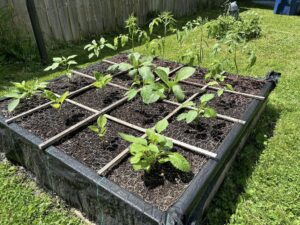
Chicken wire protection from critters.
I’ve had to deal with squirrels digging up the soil and stray cats using the beds as a litter box. Over the years, I’ve come up with some creative ways to prevent that. For the past few seasons, I’ve been using 1-foot squares of chicken wire placed around the base of each plant. They fit snugly under the grid. It was a lot of effort to cut out all the squares but I re-use them every year.
For some crops, I simply poke the seedlings right through the holes and into the soil. For others, like tomatoes and peppers, I plant them first, then add the chicken wire. In those cases, I cut a slit from the edge to the center of the square so I can open it up and wrap it around the base of the plant.
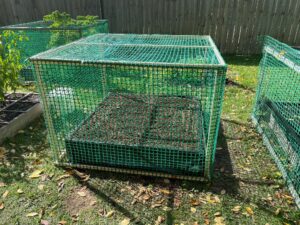
DIY critter cage.
This chicken wire method has worked really well for me. The only beds I don’t use it in are the ones with garlic and root vegetables. It doesn’t make sense to lay down the chicken wire and then try to pull out a carrot or beet. For those beds, I use cages for protection instead. To make the cages, I use 1×2 wood to build frames that are 5×5 feet, which fit easily over my 4×4 garden beds. I attach green plastic fencing to the frames, and that’s it. They tilt up and down easily over the bed when I need access.
I also try to group crops that don’t rely on pollination into one bed so I can keep them caged. For example: carrots, beets, radishes, kale, celery and parsley. I do the same with garlic.

Template for planting carrots.
Q: Your carrots always look beautiful! Many people struggle with carrot germination. What is your tip for successful germination of carrots?
I’ve tried a few different varieties, but Danvers seems to grow best for me. I’ve never had problems germinating carrot seeds, and here is my method. I made a 1-foot square template with sixteen holes, which I use for planting the carrot seeds. I usually plant at the beginning of April. I attach my grid and lay the template over each square I plan to plant. I use one of Mel’s essential gardening tools (a pencil) to poke holes in the soil, then drop a pinch of seeds into each hole. I cover the holes, gently water the squares, and place my protective cage over the bed. If the temperature gets close to freezing, I’ll sometimes put plastic over the cage to create a makeshift greenhouse.

Winter harvested carrot.
Q: Do you keep any crops growing through the winter?
Yes, usually carrots and kale. I’ve kept carrots in the ground all the way through winter and into the following spring. Kale is very hardy, though it doesn’t hold up as well during extended freezes. To prepare my Square Foot Garden for winter, I usually add compost and cover it with a tarp.
Q: What is your approach to crop rotation?
I practice crop rotation every year using five 4×4 SFG beds built with 2×10 wood. I purposely made them 10 inches deep for planting root vegetables. Each season, I have the same combination of crops planted for each bed. Two beds are used for tomatoes, peppers, eggplants, and flowers. One bed is reserved for carrots, kale, parsley, radishes, and other root vegetables. Another bed contains lettuce, spinach, beans, cilantro, and more flowers. In the fifth bed, I grow garlic. When the garlic is harvested in July, I add compost and some blood meal. Then I take the cilantro that has gone to seed and lay them on top of this bed. Later in the summer, I plant lettuce and spinach in that same bed. In mid-October, when it’s time to plant garlic again, I plant it in the bed where I was previously growing lettuce, spinach, and cilantro. Each year, I rotate the combination of plants to a different bed.
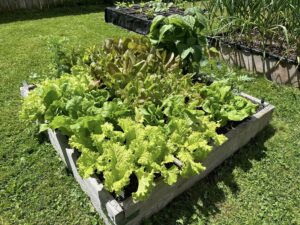
Growing lettuce, spinach and cilantro.
Q: What would you recommend to a new gardener?
Patience, adaptability, and resourcefulness.
Take time to learn about gardening, ask questions, and follow through with what you’ve started. I’ve seen many people get excited in the spring about starting a garden and then lose interest and motivation as the season progresses. Gardening requires time, dedication, and consistent effort.
Q: Some people hesitate to start SFG because they worry about the cost. Do you have any tips for gardening on a budget?
When I first started, I began with just one 4×4 bed, and the most expensive part of getting started was the Mel’s Mix. The vermiculite was the priciest component, but the 4-cubic ft bag I got was enough to fill a second bed the following year.
As for the wood, I recall Mel saying in his book that “the best wood is free wood.” I’m always on the lookout for reclaimed wood and trash finds. Big-box hardware stores sometimes have boards marked with spray paint, which they sell at a discount. This is how I got some of the lumber for my beds. I’m also lucky to have access to wood and lumber from shipping materials at my job. My last option is paying full price. While the initial cost can be high, I think it’s worth the investment if you’re committed to the SFG Method.

